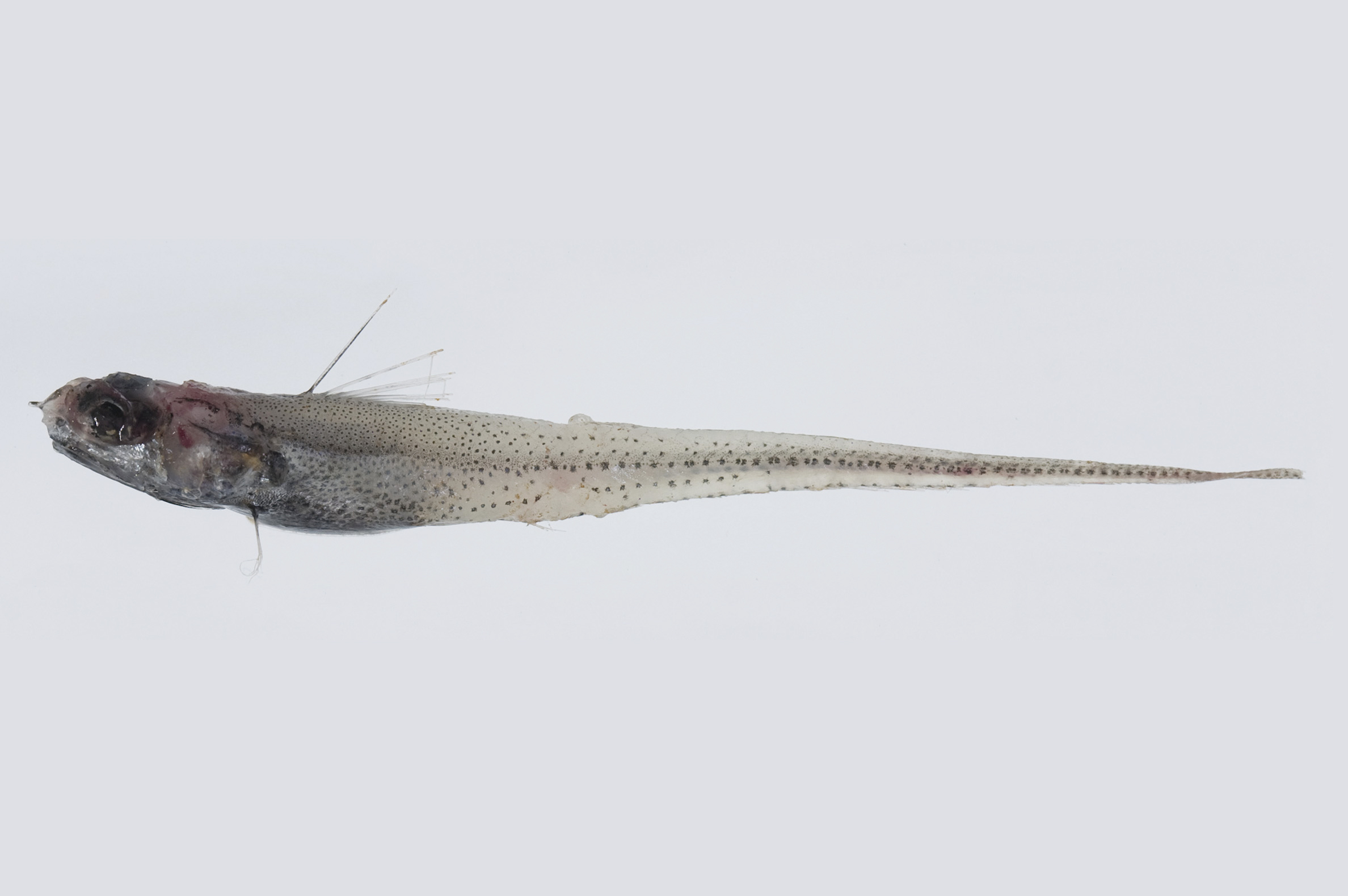Delicate Whiptail, Hymenogadus gracilis Gilbert & Hubbs 1920
Other Names: Graceful Grenadier, Slender Membranehead

A Delicate Whiptail, Hymenogadus gracilis, from the Norfolk Ridge, depth 322 m, CSIRO H6007-18 (12 mm HL, 63+ mm TL). Source: Robin McPhee & Mark McGrouther / NORFANZ Founding Parties. License: All rights reserved
Summary:
A small slender membranehead with a distinctive mid-lateral line of large melanophores running along the tail, a long chin barbel, many small melanophores on the upper body and anterior part of tail above the mid-lateral-line, and larger melanophores dispersed on the lower body and anteriorly on tail below mid-lateral-line. The head is mostly pale except for blackish pigment along the dorsal margin of snout, the interobital region, the lips, the ventral edge of the suborbital shelf, and ventral parts of the preopercle. The mouth, including the tongue, and branchial cavity is pale, and the barbel is pale or transparent.
In Australia, this species was previously known as Hymenocephalus gracilis.
In Australia, this species was previously known as Hymenocephalus gracilis.
Cite this page as:
Bray, D.J. 2017, Hymenogadus gracilis in Fishes of Australia, accessed 02 Jul 2025, https://fishesofaustralia.net.au/Home/species/3788
Delicate Whiptail, Hymenogadus gracilis Gilbert & Hubbs 1920
More Info
|
Distribution |
Off eastern and western Australia. Elsewhere the species is widespread in the North Atlantic Ocean (both sides) including the Mediterranean Sea, east coast of Africa, the Pacific Ocean off Japan, Philippines, New Caledonia, New Zealand and the Sala-y-Gomez Ridge (southeast Pacific Ocean). |
|
Features |
Diagnosis. Spinous second dorsal-fin ray weakly serrated, more obvious near tip of ray; pelvic-fin rays 7–10, usually 8–9; gill rakers first arch (outer/inner) 8–12/14–18; barbel large, length 20–30% HL; snout length short 16–26% HL; suborbital very narrow 4–8% HL; upper jaw length 43–52% HL; one row of enlarged melanophores along lateral mid-line of the tail; body cylindrical. A small species to 130 mm TL. |
|
Colour |
Head mostly pale but blackish along dorsal margin of snout, interobital region, lips, ventral edge of suborbital shelf, and ventral parts of preopercle. Mouth, including tongue, and branchial cavity pale. Barbel pale or transparent. Dorsal surface of trunk and anteriorly on tail above mid-lateral-line with many small melanophores. Trunk and anteriorly on tail below mid-lateral with dispersed large melanophores. Distinctive mid-lateral line of the largest melanophores running along tail. |
|
Author |
Bray, D.J. 2017 |
Delicate Whiptail, Hymenogadus gracilis Gilbert & Hubbs 1920
References
Gilbert, C.H. & Hubbs, C.L. 1920. Contributions to the biology of the Philippine Archipelago and adjacent regions. The macrouroid fishes of the Philippine Islands and the East Indies. Bulletin of the United States National Museum 100 (1)7: 369–588.
Iwamoto, T. 1990. Macrouridae. In: Cohen, D.M., Inada, T., Iwamoto, T. & Scialabba, N. FAO species catalogue. Vol. 10. Gadiform fishes of the world (Order Gadiformes). An annotated and illustrated catalogue of cods, hakes, grenadiers and other gadiform fishes known to date. FAO Fisheries Synopsis, 125(10): 90–317.
Iwamoto, T. & Merrett, N.R. 1997. Pisces Gadiformes: Taxonomy of grenadiers of the New Caledonian region, southwest Pacific. In: Crosnier, A. Résultats des Campagnes MUSORSTOM 18. Mémoires du Muséum National d'Histoire Naturelle 176: 473–570.
Iwamoto, T., Shao, K.-T. & Ho, H.-C. 2011. Elevation of Spicomacrurus (Gadiformes: Macrouridae) to generic status, with descriptions of two new species from the southwestern Pacific. Bulletin of Marine Science 87(3): 513–530.
McMillan, P. & T. Iwamoto. 2014. Descriptions of four species of grenadier fishes of the genera Hymenocephalus and Hymenogadus (Teleostei, Gadiformes, Macrouridae) from the New Zealand region and Tasman Sea, including two new species of Hymenocephalus. Zootaxa 3856(1): 117-134.

